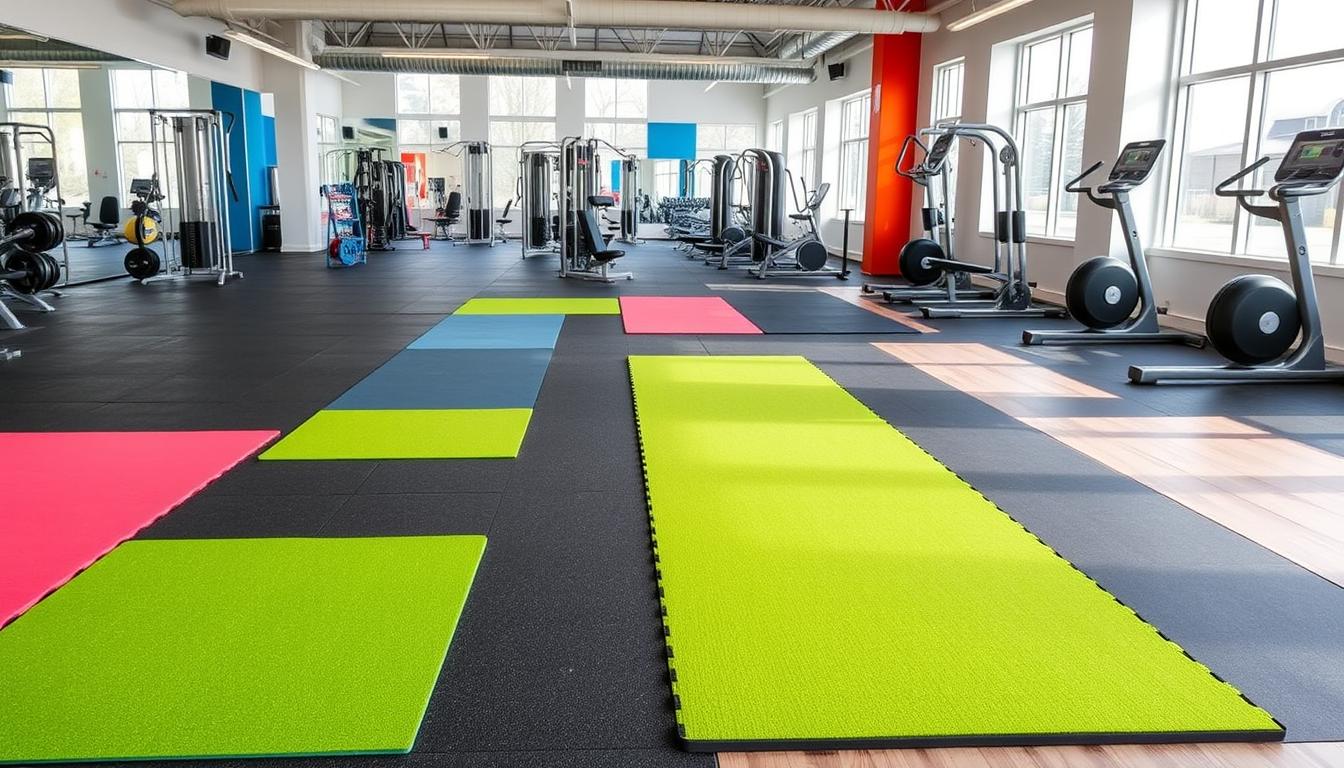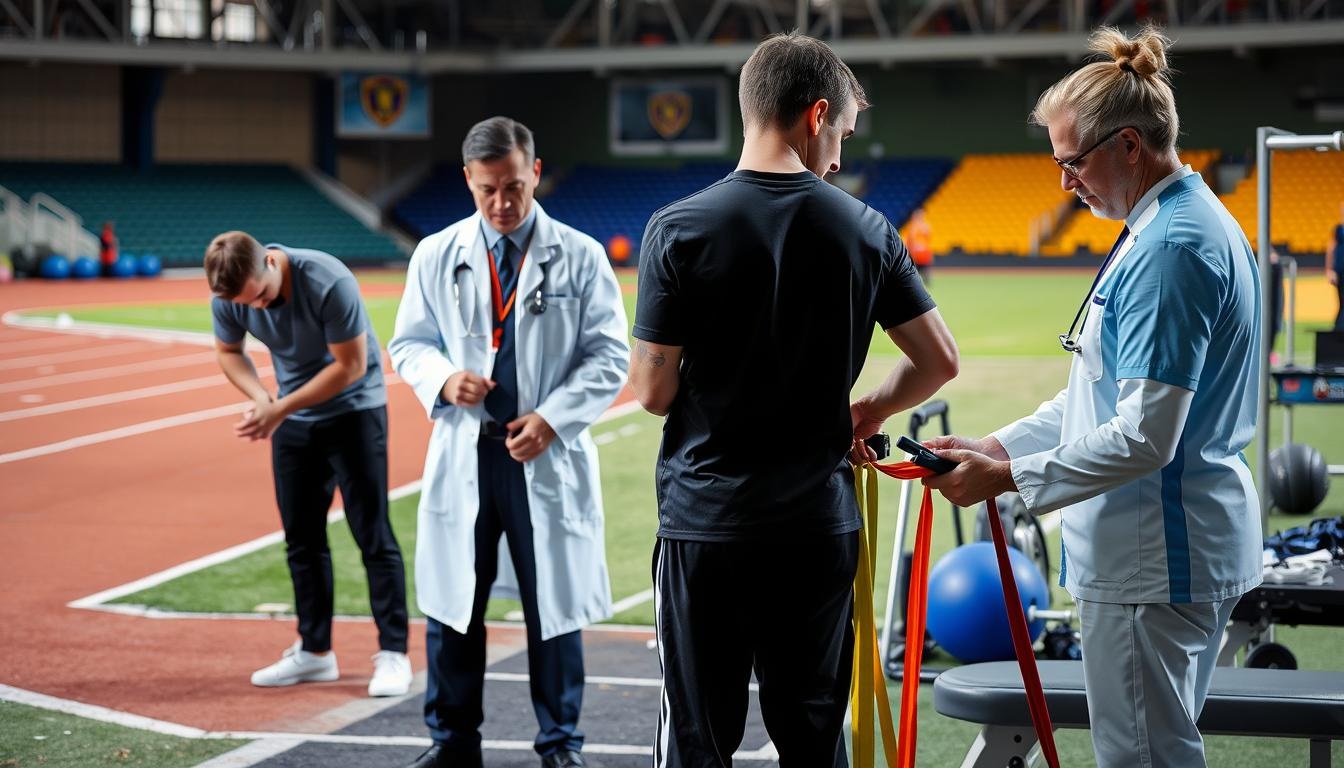I used to be skinny and struggled to gain muscle. But I learned that with the right approach, anyone can build muscle. In this guide, I’ll share strategies that have helped me and many others.
This guide is for everyone, whether you’re new to fitness or have been working out for years. We’ll cover the basics of weight training and nutrition. You’ll learn how to create a workout plan and track your progress.
Let’s start this journey together. Get ready to see amazing changes in your body and mind when you focus on muscle gain.
Understanding Muscle Gain
Muscle gain, or hypertrophy, is about growing muscle size and strength. It happens through specific exercises and diet. This is a key part of strength training that boosts your health, metabolism, and performance.
What is Muscle Gain?
Muscle gain means your muscles get bigger and more defined. It’s caused by resistance training, good nutrition, and enough rest.
Why Muscle Gain Matters
Building muscle is vital for many reasons. It boosts your metabolism, increases physical strength and endurance, and improves your health and well-being. It also helps keep a healthy body shape and stops muscle loss as you age.
Basics of Weight Training
- Proper form and technique are essential for safe and effective muscle growth.
- Progressive overload, where you gradually increase the challenge of your workouts, is a key principle of muscle building.
- Consistency in your training program, with a focus on compound exercises that engage multiple muscle groups, is crucial for muscle hypertrophy.
Understanding muscle gain and weight training basics helps you create a good workout plan. This plan supports your fitness goals and helps you achieve a strong, healthy body.

“Muscle growth is a complex process that requires a strategic approach to training and nutrition. With the right knowledge and dedication, you can unlock your full potential for muscle hypertrophy.”
Setting Your Muscle Gain Goals
To reach your fitness goals, you need to set clear and measurable targets. Muscle gain goals should be Specific, Measurable, Achievable, Relevant, and Time-bound (SMART). This helps you stay focused and motivated.
Defining Realistic Objectives
First, know your current fitness level and muscle mass. Then, set goals like increasing muscle mass by a certain percentage. Or, aim to boost your strength in key exercises. Remember, muscle gain is a slow process that requires patience and effort.
Importance of Measurable Goals
- Tracking your progress keeps you motivated and on track. Measurable goals help you see how well you’re doing over time.
- Examples of measurable goals include lifting 20 pounds more on the bench press, gaining 10 pounds of muscle, or lowering body fat by 3%.
- By regularly checking your bodyweight, measurements, and lifts, you can adjust your workout and diet plan as needed.
Setting SMART muscle building goals helps you map out your fitness journey. Stay patient and consistent for lasting muscle gain.

| Specific | Measurable | Achievable | Relevant | Time-bound |
|---|---|---|---|---|
| Increase muscle mass in my arms by 2 inches | Measure arm circumference weekly | Based on my current muscle building capabilities | Aligns with my overall muscle building objectives | Aim to achieve this goal in 6 months |
| Improve my bench press by 50 lbs | Track bench press weight and reps | Reasonable with consistent training | Supports my strength and muscle gain goals | Work towards this in the next 12 months |
| Reduce my body fat percentage by 5% | Measure body fat percentage monthly | Achievable through diet and exercise | Enhances my overall physique and health | Target to reach this goal in the next 9 months |
The Science Behind Muscle Growth
Muscle growth is a complex process. It involves several key physiological mechanisms. The foundation of muscle growth is muscle protein synthesis. This process creates new muscle proteins, leading to bigger muscles and more strength.
The Role of Protein
Adequate protein intake is crucial for muscle repair and growth. You should eat 1.7 to 2 g of protein per kilogram of body weight for optimal muscle protein synthesis. Try to eat three to four meals with at least 25 g of protein every five to six hours to help your muscles grow.
Importance of Recovery
Muscle growth doesn’t just happen during workouts. It also happens during recovery. Proper recovery lets your muscles repair and get stronger. Make sure to include rest days and give your muscles enough time to recover between intense workouts.

“Muscle growth is a complex process that requires a balance of proper nutrition, strategic training, and adequate recovery.”
Understanding the science behind muscle growth helps you optimize your workout and nutrition. Remember, consistency and patience are key to building muscle.
Nutritional Guidelines for Muscle Gain
To grow muscle, you need a smart diet plan. Understanding macronutrients and meal planning is key to reaching your goals.
Macronutrients Explained
The three main macronutrients are protein, carbs, and healthy fats. For muscle gain, eat a bit more than you burn, focusing on protein intake (1.6 to 2.2 grams per kilogram). Carbs should be 3.5 to 5 grams per kilogram to power your workouts. Healthy fats (0.5 to 1.5 grams per kilogram) are important for nutrients and hormone support.
Meal Planning Tips
- Eat foods rich in nutrients and protein like lean meats, eggs, dairy, legumes, and whole grains.
- Each meal should have 400 to 600 calories, with a mix of macronutrients for muscle building.
- Divide your protein intake into 3 to 5 meals, aiming for 0.4 to 0.55 grams per kilogram per meal.
- Drink 9 cups of water daily for women and 13 cups for men to stay hydrated.
- Include healthy snacks like nuts, fruits, and yogurt to meet your calorie surplus needs.
Supplements for Muscle Building
While a balanced diet is essential, some supplements can help. Whey protein, creatine, and BCAAs can aid in muscle recovery and growth. Always talk to a healthcare professional before adding supplements to your routine.
By following these guidelines and adjusting your diet to fit your needs, you can boost your muscle-building efforts. This will help you reach your fitness goals.

Designing Your Workout Template
Creating a good muscle gain workout template needs careful thought. It’s all about the right workout structure, training frequency, and exercise selection. These elements help make a plan that challenges your muscles and helps them grow.
Key Components of a Workout Plan
For the best muscle gains, do at least 2-3 strength training workouts a week. Each workout should last about 30 minutes. This makes it easy to fit them into your busy schedule.
Each workout should have 10 rounds. Do the exercises in an “EMOM” (Every Minute On the Minute) format. Start with 50-60% of the total reps you can do, then increase the intensity as you get stronger.
Progressive Overload Principles
Progressive overload is crucial for muscle growth. Keep track of your weights and reps in every workout. Try to do better than before on each exercise. This will keep your muscles challenged and growing.
Use a mix of compound and isolation exercises for different muscle groups. Changing your exercises keeps your muscles guessing and prevents plateaus. Update your workout plan every 4 sessions to keep making progress.

“The secret to muscle growth lies in the principles of progressive overload and strategic exercise selection. By consistently challenging your body, you’ll unlock your true muscle-building potential.”
Sample Muscle Gain Workout Template
Creating a good workout plan is key for growing muscles. The push/pull/legs split is a common method. It divides your workout into 6 days, focusing on different muscle groups. This approach helps you grow muscles evenly and effectively.
Weekly Schedule Overview
Here’s a weekly plan for muscle gain:
- Day 1: Push (chest, shoulders, triceps)
- Day 2: Pull (back, biceps)
- Day 3: Legs
- Day 4: Push
- Day 5: Pull
- Day 6: Legs
- Day 7: Rest
Day-by-Day Breakdown
Each day in this workout split focuses on big exercises and smaller ones. Do 3-4 sets of 8-12 reps for each exercise. This helps grow your muscles the most.
| Workout | Key Exercises | Sets x Reps |
|---|---|---|
| Push | Bench Press, Overhead Press, Dumbbell Flyes, Lateral Raises, Triceps Extensions | 3-4 x 8-12 |
| Pull | Pull-ups, Lat Pulldowns, Dumbbell Rows, Bicep Curls | 3-4 x 8-12 |
| Legs | Squats, Deadlifts, Leg Press, Calf Raises | 3-4 x 8-12 |
By sticking to this training program, you’ll hit all major muscle groups. This leads to balanced muscle gain across your body.
Essential Exercises for Muscle Gain
To build muscle, you need a mix of compound exercises and isolation movements. Compound exercises like squats, deadlifts, and bench presses work many muscles at once. They are key for muscle growth, strength, and a balanced body.
Isolation exercises, like bicep curls and tricep extensions, focus on specific muscles. Mixing both types helps target weak spots and build a complete physique.
Balancing Workout Types
It’s important to balance compound and isolation exercises for muscle gain. Aim for 50% of each in your routine. This balance helps grow muscles and increase strength.
| Exercise Type | Examples | Benefits |
|---|---|---|
| Compound Exercises |
|
|
| Isolation Exercises |
|
|
By mixing compound exercises and isolation movements, you can grow muscles, boost strength, and reach your fitness goals.
Monitoring Your Progress
Tracking your workout progress and measuring muscle growth are key steps in your muscle-building journey. By keeping an eye on your performance and physical changes, you can stay motivated. You can also spot areas for improvement and adjust your training program as needed.
Tracking Your Workouts
Keeping a detailed record of your workouts is vital for tracking progress. Use a workout log or a digital tool like Google Sheets to track the weights, reps, and sets for each exercise. This data helps you see your strength gains over time and ensures you’re pushing yourself harder with each workout.
Measuring Muscle Growth
Measuring your body regularly is another way to track muscle growth. Take measurements of your biceps, chest, waist, and other key areas, and record them in your workout log or a fitness app. Progress photos can also show your physical changes visually.
For a deeper look at muscle growth, consider a body composition analysis. Tools like a body fat percentage scale or an InBody scanner can give insights into your lean muscle mass. This helps you track your progress more accurately.
Remember, progress takes time. Be patient, stay consistent, and celebrate small victories. By monitoring your workouts and measuring muscle growth, you can stay motivated and ensure you’re on the right path to your muscle-building goals.
“Consistent measurement and tracking are the keys to maximizing your muscle-building progress. Stay dedicated, and watch your gains unfold over time.”
Common Myths About Muscle Gain
Building muscle has many misconceptions that can slow you down. Let’s clear up some common myths and share the real facts about nutrition and fitness.
Debunking Popular Misconceptions
One big myth is that you must lift super heavy to build muscle. But, it’s really about progressive overload, not just lifting the heaviest. Focus on proper form and slowly increase the intensity of your workouts for better muscle growth.
Another myth is “spot reduction,” thinking you can lose fat in specific areas. But, fat loss happens all over your body, not just in one spot. You can’t target fat loss with specific exercises.
Understanding Nutrition Myths
Nutrition myths can also hold you back. One myth is that you need a lot of protein, especially from shakes. While protein is key, you only need about 1-1.6 grams per pound of body weight, based on how active you are.
Another myth is that supplements like creatine or pre-workouts are must-haves for muscle gain. While they can help, they’re not a magic fix. A balanced diet should be your main focus for building muscle.
For real muscle gain, combine progressive overload in workouts, a balanced diet, and consistency. Don’t fall for myths. Stick to proven methods for lasting muscle growth.
The Role of Consistency
Building muscle is tough, and it’s normal to feel discouraged. But, workout consistency is key to success. It’s the base of your long-term fitness goals.
Building a Sustainable Routine
To keep up with workouts, make a routine that fits your life. Don’t aim for too much too soon. Start with a plan you can keep up with, like three or five days a week. The benefits of sticking to it will be worth the initial effort.
Staying Motivated on Your Journey
Keeping up motivation is vital for consistent workouts. Set goals for the short and long term. Celebrate your wins and track your progress. Muscle gain takes time, so stay patient and keep going.
“Consistency is the key to long-term success in any fitness endeavor. It’s not about perfection, but about showing up, day in and day out, and putting in the work.” – Fitness Guru, John Doe
Remember, workout consistency isn’t about being perfect. It’s about making lasting habits and enjoying the journey. With a good routine and motivation, you’ll reach your muscle gain goals.
Adjusting Your Template Over Time
As you get better at building muscle, it’s key to keep checking and tweaking your workout plan. Sticking to the same routine can cause boredom and slow progress. Making smart changes helps you keep growing and keeps your muscles ready for new challenges.
When to Make Changes
Watch for signs that it’s time to change your workout. If you’re not getting stronger or gaining muscle, it’s a clue. Feeling tired of your routine or reaching a goal are also good reasons to switch things up.
Signs You Need to Switch it Up
There are many ways to mix up your workout, like changing the order of exercises or adding new ones. You can also tweak the number of sets and reps. These tweaks keep your muscles growing and your workouts exciting.

















Leave a Reply